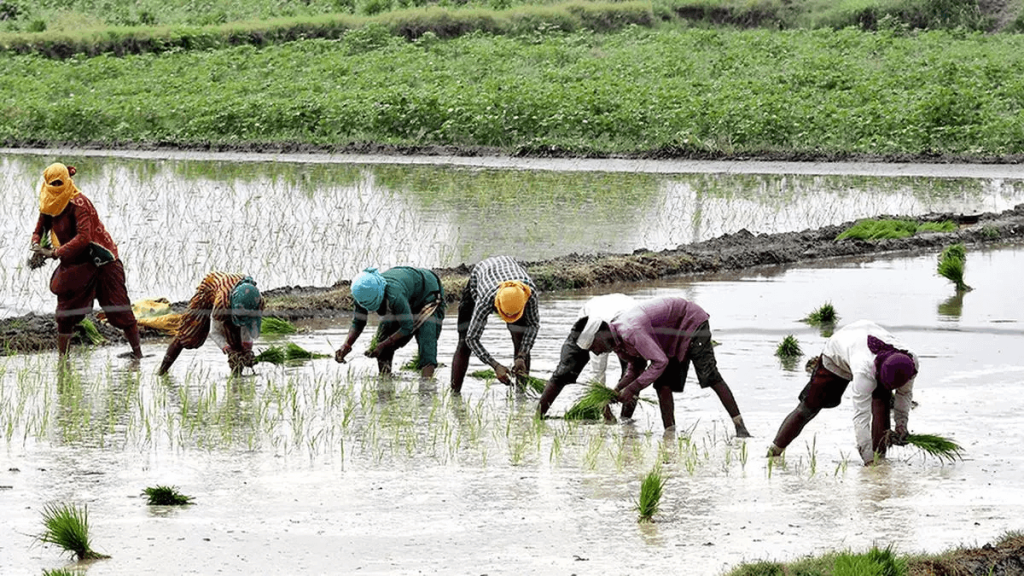Tags
Digital crop survey unearths unusually high acreage under paddy
Experts feel farmers may have shifted to paddy from cotton and pulses.
By Prabhudatta Mishra

The area under kharif paddy this year is believed to have increased by over 65 lakh hectares (lh) from 407 lh in the previous year, as per digital crop survey of the Agriculture Ministry. In the past five years, the average acreage has been 401.6 lh.
However, considering that it is highly unusual to have such an increase in a single year, the government is extremely cautious in arriving at the first estimate of the area and production of crops. The usual practice is to release the estimate in the third week of September.
Gradual adoption
A senior Agriculture Ministry official said the delay in crop estimate release has nothing to do with the acreage issue and it will be released soon. The area and production of crops will be known once it is finalised, taking into consideration all the inputs, including field survey as well as digital survey, the official said.
“Since digital crop survey has been on pilot basis, its adoption into the system will be gradual. However, considering the importance of the production estimate in policy making, the Government has been focussing on digital agriculture and crop survey is one part of it,” an official source said, adding the recently approved Digital Agriculture Mission by the Cabinet will drive the initiative.
The Agriculture Ministry has been discussing with experts on the increased area under paddy as the manual survey had put only 10 lakh hectares higher area. The weekly crop weather watch group had estimated crop area under Kharif season’s paddy at 414.5 lh as on September 27 as against 404.5 lh a year ago.
Two factors
Scientists are of the views that it is possible to see the jump in area under paddy mainly due to two factors – market prices of rice that drive farmers to take a decision on which crop to sow and the other is good rainfall.
“It is nothing unusual for farmers to sow paddy in upland areas when rainfall is good as its seeds are readily available, compared to other crops,” said an agriculture scientist. However, the area expansion of paddy has to be validated with competing crops in a State where acreage is reportedly higher, he said, adding that farmers may have been shifted from pulses, maize and cotton area.
The south-west monsoon season (June-September) was 7.6 per cent “above normal” with as many as 89 per cent of the geographical area receiving “normal” or higher rainfall.
Overall acreage of cotton in the country declined by 10.76 lh to 112.95 lh from 123.71 lh. At the micro level, urad sowing has dipped in the largest producing State, Madhya Pradesh, to 9.8 lh from 13.9 lh whereas the area under paddy increased to 36 lh from 33.11 lh in the State.
Validation of survey
“Higher paddy area can be a possibility as increasing trend has been observed in a few States in the north. Based on previous years’ trends in basmati, there was a positive trend in terms of productivity. The same trend is being repeated this year. Although this can be a probabilistic analysis with a possibility of deviation on either side, there is certainly an indication of a positive trend,” said Navneet Ravikar, CEO of Leads Connect Services, which had conducted basmati crop survey for APEDA in 2022 and 2023. APEDA has discontinued the survey this year.
Having said that, digital crop surveys should be validated by sample crop survey as part of the estimation methodology, Ravikar said, adding that field survey will still have to validate what AI and digital crop surveys are showing.
Experts also said the government seems to have been taking the inputs of digital crop survey seriously as many decisions on trade have been announced recently including lifting the export ban on white rice and scrapping of the minimum export price (MEP) on basmati.
Crop production estimates have been an area of focus by the Ministry over the past 2-3 years since technology infusion was not done earlier, sources said. The wheat production estimate for 2021-22 crop year was pegged by the Ministry at 107.74 million tonnes (mt), which was questioned by experts and industry as the government procurement also dropped to a 15-year low of 18.8 mt, amid high prices.
Though the government’s production estimates of wheat has been rising after 2021-22, the export ban is yet to be lifted.
Published Date: October 21, 2024






